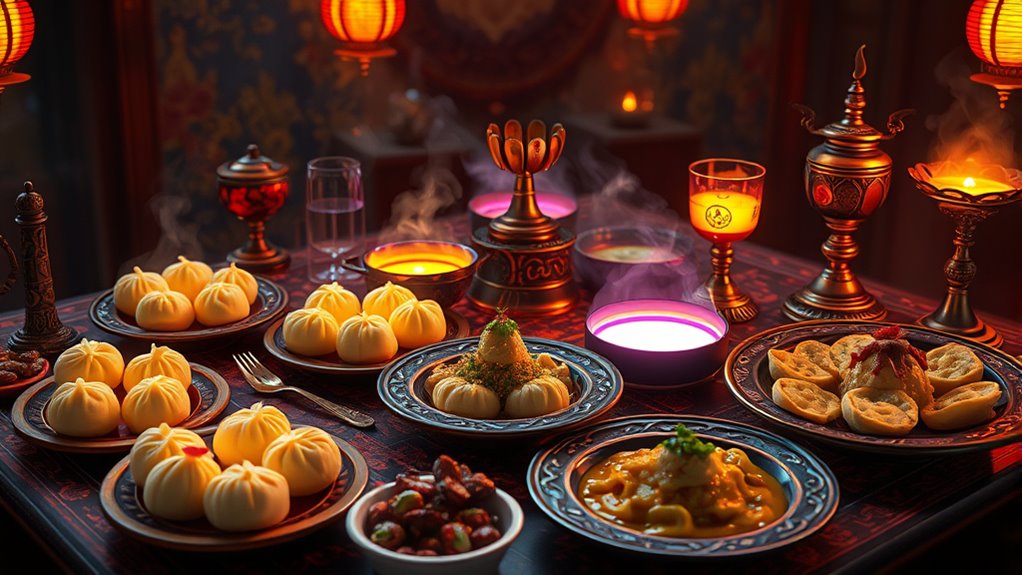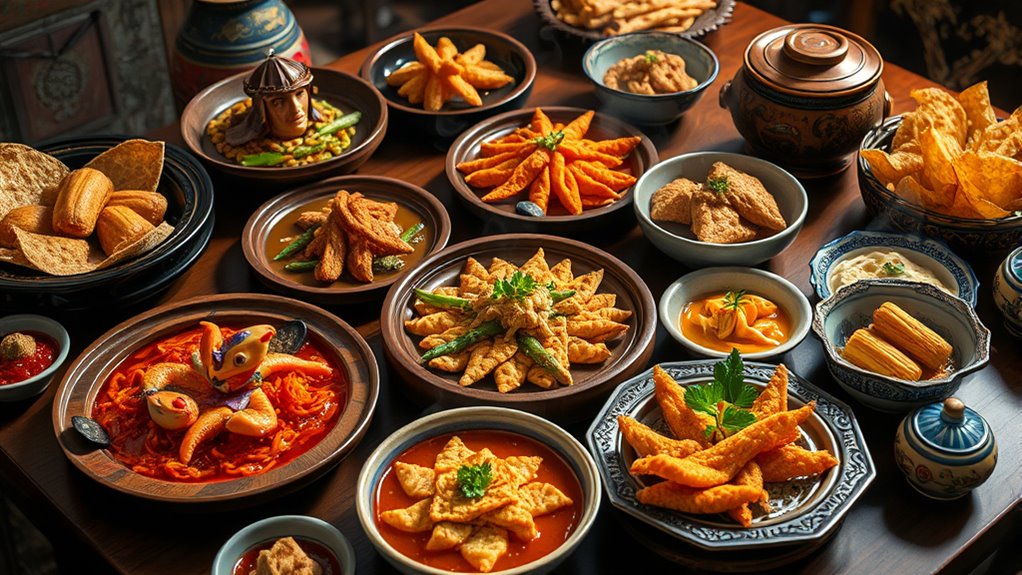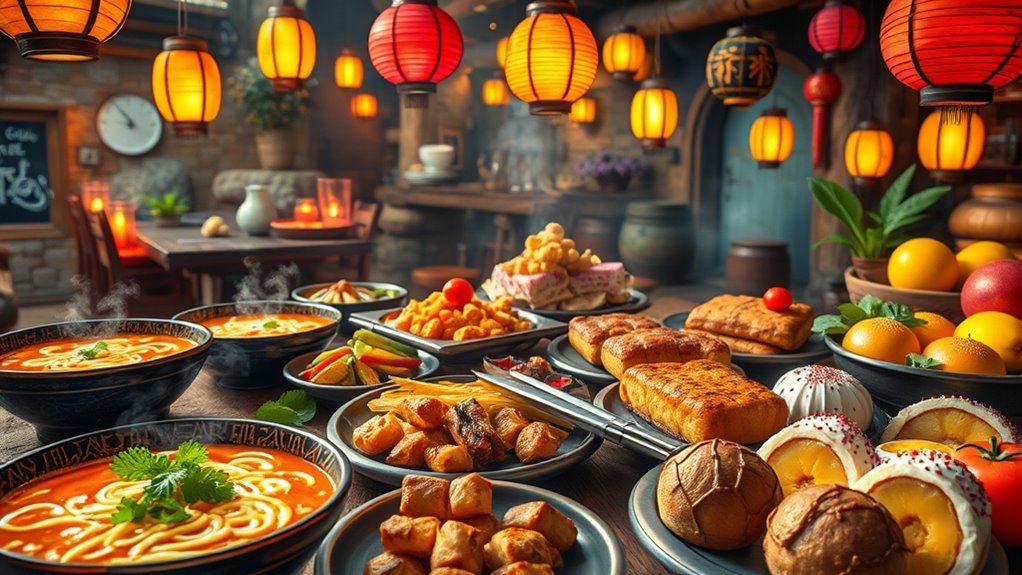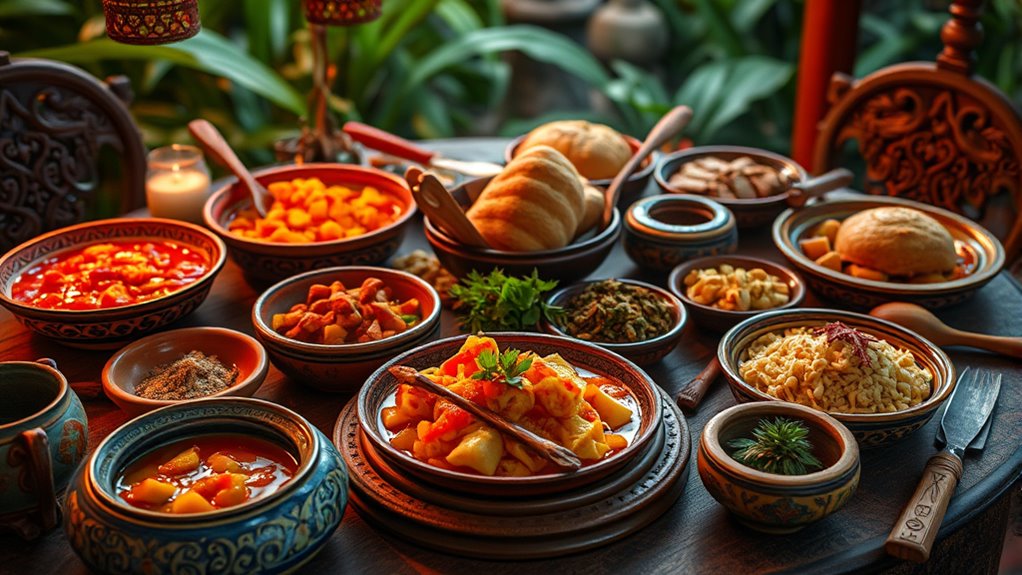Video game cuisine reflects diverse culinary traditions, from authentic regional dishes to culturally inspired recipes, enriching gameplay and world-building. You’ll find mechanics that involve managing ingredients, preparing multi-step recipes, and authentic cooking techniques. Food also acts as a symbol of cultural identity, fostering emotional bonds and nostalgia. As you explore, you’ll discover how games use cuisine to deepen immersion, promote social interactions, and teach about different culinary customs worldwide — just continue to uncover more.
Key Takeaways
- Many video games feature authentic regional dishes like sushi, pasta, and tacos to promote cultural appreciation.
- Culinary mechanics in games evolve from simple ingredient assembly to complex, skill-based cooking simulations.
- Food in games often symbolizes cultural identity, tradition, and nostalgia, fostering emotional connections.
- Incorporating authentic ingredients and techniques enhances world-building and immerses players in diverse culinary cultures.
- Multiplayer and social features around food promote community, cooperation, and shared cultural experiences.
The Evolution of Cooking Mechanics in Video Games

The evolution of cooking mechanics in video games reflects how developers have progressively integrated culinary activities into gameplay to enhance immersion and challenge. In early titles like *Burger Time*, you manually assembled burgers by walking over ingredients, creating a simple but engaging mechanic. As technology advanced, games like *Cooking Mama* utilized touch controls to simulate cooking steps, making the process more interactive. Survival games such as *Don’t Starve* made cooking essential for survival, deepening gameplay complexity. Over time, developers incorporated cultural influences and crafting systems, adding layers of resource management and multi-step recipes. Additionally, the incorporation of cultural influences has allowed for a richer and more diverse portrayal of culinary traditions within gaming environments. These innovations transformed cooking from a basic task into a crucial, immersive component that enriches gameplay and offers new challenges, blending culinary arts with game design.
Food as a Catalyst for Power and Progression

Food plays a crucial role in driving player progression and granting power within many video games. You rely on it not just for sustenance but to reveal new abilities, improve stats, or gain advantages. For example:
Food fuels player growth, unlocking new skills, boosting stats, and encouraging exploration in video games.
- Consuming specific items boosts your health or stamina, keeping you alive longer.
- Certain foods grant temporary buffs, increasing speed, strength, or defense.
- Gathering rare ingredients unlocks powerful recipes, enhancing your character’s skills.
- Feeding characters or NPCs reveals story progress or special quests.
- Prioritizing food collection encourages exploration and risk-taking.
- Proper nutrition and balanced diet in games can also contribute to overall character development and longevity.
Cultural Significance and Representation in Gaming Cuisine

Cultural significance deeply influences how cuisines are depicted and celebrated in video games, allowing you to explore diverse culinary traditions from around the world. When games incorporate authentic dishes and cooking techniques, they foster appreciation for different cultures and histories. You might encounter Japanese sushi, Italian pasta, or Mexican tacos, each representing unique cultural identities. These representations often go beyond mere visuals, teaching players about regional ingredients, cooking styles, and social customs. By highlighting specific foods and culinary practices, games create a sense of authenticity and respect for cultural diversity. This fosters a deeper connection to the material, encouraging curiosity and understanding. The use of accurate cultural details helps ensure respectful and meaningful portrayals of different culinary traditions. Ultimately, gaming’s portrayal of cuisine becomes a form of cultural exchange, enriching your experience while honoring global culinary heritage.
The Role of Food in Enhancing Player Engagement and Social Interaction

Engaging with cooking mechanics in video games often encourages players to connect and interact beyond solo gameplay. When you cook with friends or compete in cooking challenges, you boost teamwork and social bonds. These experiences can include:
- Cooperative cooking tasks that require coordination
- Leaderboards showcasing high scores for dishes prepared
- Multiplayer mini-games centered on food preparation
- Sharing recipes or tips within gaming communities
- Hosting virtual dinner parties or events
- Incorporating sustainable energy practices into in-game activities to promote environmental awareness
Such activities make gameplay more immersive and foster community. They inspire friendly competition and collaboration, turning gaming into a social experience. Food-related mechanics serve as a bridge that brings players closer, encouraging communication and shared achievement. This dynamic profoundly enhances engagement and builds lasting social connections within gaming environments.
Diversity of Culinary Traditions Depicted in Video Games

Video games increasingly showcase a rich tapestry of culinary traditions from around the world, offering you a taste of diverse cuisines. You might explore authentic Italian pasta dishes in *Cook, Serve, Delicious!*, or delve into spicy Asian street foods like ramen and satay. Games like *Overcooked* feature regional flavors, encouraging you to master recipes from Italy, Japan, or Mexico. Some titles, such as *Cafe World* or *Food Network*, highlight specific culinary cultures, teaching players about ingredients and techniques. You’ll also find games that integrate regional spices, cooking styles, and presentation methods, making each culinary tradition distinct. This diversity not only entertains but also educates, exposing you to global cuisines and enriching your understanding of different food cultures through interactive gameplay. Additionally, many of these games incorporate home decoration inspiration that reflects regional aesthetics, helping you envision how to incorporate diverse culinary themes into your own kitchen space.
Complexities of Cooking: Crafting, Timing, and Technique Simulation

As games explore diverse cuisines, they also introduce players to the intricate skills involved in preparing authentic dishes. You’ll find that cooking mechanics often require mastering precise timing, crafting multi-step recipes, and executing techniques like chopping, frying, or simmering. These elements add depth and challenge, making each dish feel rewarding. Incorporating antique pieces can also enhance the visual authenticity of traditional culinary settings within the game, adding to the immersive experience.
- Timing button presses to simulate real-world cooking actions
- Managing multiple ingredients and steps simultaneously
- Using precise gestures or inputs for techniques like slicing or stirring
- Balancing resource availability with recipe complexity
- Completing sequences under time constraints to disclose new dishes
This complexity encourages focus, skill development, and immersion, transforming simple meal prep into a compelling gameplay experience. The more authentic the simulation, the more satisfying your culinary accomplishments feel.
Food as a Resource: Managing Supplies and Recipes in Gameplay

Managing supplies and recipes is a core aspect of many cooking-focused games, requiring you to gather, conserve, and strategically use ingredients to succeed. You must explore environments, collect resources, and decide which ingredients to prioritize, balancing availability with recipe requirements. Efficient inventory management becomes essential, as limited space forces you to choose between different foods and tools. Recipes often need specific ingredients, so you plan meals carefully to maximize resources and avoid waste. Timing and order matter—using ingredients at the right moment can access new dishes or bonuses. Some games introduce crafting systems where combining resources creates complex recipes, adding depth. Overall, managing supplies and recipes challenges your strategic thinking, making every decision impactful on your progress and success in the game. Understanding the importance of proper storage techniques can also help preserve ingredients and ensure consistent results.
Authenticity and Education Through Virtual Culinary Experiences

Virtual culinary experiences in video games offer more than just entertainment; they serve as effective tools for teaching and promoting authentic cooking techniques and cultural cuisines. You can learn about ingredients, traditional methods, and regional flavors while playing. These experiences help you develop a deeper appreciation for different cuisines and understand their cultural significance. Additionally, just as WWE Raw influences pop culture and generates billions in revenue, these virtual experiences can significantly impact your understanding and appreciation of diverse culinary traditions. Authentic recipes from around the world can be discovered, practice cooking techniques like chopping, frying, and simmering, explore cultural traditions through food presentation and rituals, gain knowledge of ingredients and their origins, and enhance your culinary vocabulary and skills in a fun way.
Regional Flavors and Their Impact on Game World-Building

Regional flavors play a essential role in shaping the immersive worlds of video games, allowing developers to create distinct cultural identities through cuisine. By incorporating authentic ingredients, cooking techniques, and traditional dishes, games can evoke a sense of place and history. For example, a game set in Japan might feature sushi, ramen, or tempura, giving players a taste of local culture. These culinary details deepen world-building, making environments feel lived-in and believable. Regional flavors also influence character interactions, storylines, and societal norms within the game. They can highlight cultural values or historical influences, enriching the narrative. Additionally, regional cuisine can serve as a storytelling device, helping to convey the environment’s climate, economy, or social structure. Ultimately, authentic regional cuisine serves as a powerful tool for crafting diverse, compelling game worlds that resonate with players and foster cultural appreciation.
Nostalgia, Identity, and Emotional Connections via Game Food

You might find yourself feeling nostalgic when certain game foods remind you of home or special memories. These dishes become symbols of cultural identity, connecting you to a broader tradition through gameplay. By sharing these foods, games create emotional bonds that resonate beyond the screen. Understanding the cultural significance of food in games can deepen our appreciation for how they reflect real-world culinary traditions.
Evoking Memories Through Food
Food in video games often acts as a powerful trigger for memories and emotions, connecting you to your own experiences or cultural backgrounds. When you see a familiar dish or prepare a loved recipe, it can evoke feelings of comfort, nostalgia, or belonging. This emotional connection deepens your immersion and personal attachment to the game. Consider how:
- Classic dishes remind you of family gatherings or holidays.
- Iconic in-game meals evoke childhood memories.
- Cultural foods reflect your heritage or curiosity about new cultures.
- Recreating recipes from games sparks a sense of achievement.
- Shared gaming experiences around food foster community bonds.
These moments turn simple gameplay into meaningful, sentimental journeys, making food more than just mechanics—it’s a bridge to your memories and identity.
Cultural Identity Expression
Eating and preparing dishes in video games often serve as a powerful way to express cultural identity and evoke personal nostalgia. When you cook traditional recipes or savor regional dishes, you’re connecting to a culture or memory that feels meaningful. These moments allow you to explore culinary customs from around the world or relive familiar tastes from childhood. Games that feature authentic ingredients and cooking techniques help you appreciate diverse traditions, fostering a sense of pride and belonging. Whether it’s recreating grandma’s favorite meal or experiencing cuisine from another country, these food moments deepen your emotional bond with the game. They remind you that food is more than sustenance—it’s a reflection of identity, history, and shared cultural stories.
Frequently Asked Questions
How Has Cooking in Video Games Influenced Real-World Culinary Practices?
Cooking in video games influences your real-world culinary practices by inspiring you to try new recipes, techniques, and cuisines. You might experiment with dishes inspired by games like *Cooking Mama* or *Cook, Serve, Delicious!*, and develop better cooking skills. These games also motivate you to learn about ingredients and cultural traditions, making cooking more engaging and educational, ultimately encouraging you to explore and enjoy real-world culinary experiences.
What Are the Most Common Cultural Cuisines Represented in Video Game Food?
Imagine walking through a vibrant marketplace like in *Aladdin*, and you see dishes from around the world. You’ll find Asian cuisines like sushi and ramen, Italian pasta, and Japanese tempura, reflecting global culinary diversity. Many games showcase regional flavors, from Mexican tacos to French pastries, helping you explore different cultures. This representation not only adds authenticity but also fosters appreciation, making you curious to try real-world recipes inspired by these virtual dishes.
How Do Game Developers Balance Realism and Fun in Virtual Cooking Mechanics?
You balance realism and fun in virtual cooking by simplifying mechanics without losing authenticity. You incorporate timed sequences, mini-games, and visual cues to make cooking engaging, while avoiding overly complex procedures that might frustrate players. You also add creative elements like exaggerated effects or unique recipes to enhance entertainment. This approach keeps players immersed, challenged, and motivated, ensuring the game remains enjoyable while still feeling believable and satisfying.
In What Ways Does Cooking in Games Promote Social Collaboration Among Players?
You can promote social collaboration in games by designing cooking mechanics that require teamwork, like preparing dishes together or managing resources collectively. You might include multiplayer challenges, where players coordinate tasks to complete recipes efficiently. Encouraging friendly competition through cooking contests or sharing dishes fosters interaction. These features make the experience more engaging, strengthen player bonds, and create a lively community centered around culinary activities within the game.
How Does Food Design in Games Reflect or Reshape Cultural Identities?
Imagine playing a game where you prepare traditional Japanese sushi, and through this, you gain a deeper appreciation for Japanese culture. Food design in games reflects or reshapes cultural identities by showcasing authentic dishes and cooking methods, fostering cultural understanding. It can also introduce players to new cuisines, broadening perspectives and allowing players to experience and even influence cultural perceptions through immersive culinary storytelling.
Conclusion
As you journey through the flavorful universe of video game cuisine, you realize it’s more than just pixels and recipes. Food becomes a tapestry woven with cultural threads, a bridge connecting players to distant lands, and a catalyst for adventure and camaraderie. It’s a mirror reflecting our own traditions and a portal to memories both sweet and savory. In this digital feast, every bite invites you deeper into a world rich with history, identity, and endless discovery.









